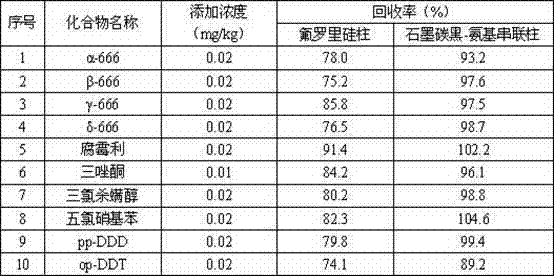Pretreatment method for detecting organochlorine pesticide residue
A pesticide residue and organochlorine technology, applied in the field of pesticide science and testing, can solve the problems of vegetable export obstruction, human and animal poisoning, etc., and achieve the effects of less reagent volume, high precision and simple operation.
- Summary
- Abstract
- Description
- Claims
- Application Information
AI Technical Summary
Problems solved by technology
Method used
Image
Examples
Embodiment 1
[0026] Example 1 A pretreatment method for detecting organochlorine pesticide residues, comprising the following steps:
[0027] ⑴ Fresh green vegetables are beaten according to conventional methods to obtain the samples to be tested.
[0028] (2) Add 40mL of acetonitrile to 20g of the sample to be tested, homogenize at a rate of 8000r / min for 2min, then add 5g of dried NaCl into a 100mL centrifuge tube with a stopper, cover and shake vigorously for 2min, then Centrifuge at a speed of 4000 r / min for 2 min, and after standing at room temperature, obtain a supernatant; finally draw 5 mL of the supernatant into a concentrated bottle, and in an environment with a speed of 180-280 r / min and a water bath temperature of 30-40°C Use a rotary evaporator under certain conditions to evaporate until the remaining 1-2mL, and then dry it with an ear wash ball to obtain a concentrate.
[0029] (3) Add 10 mL of eluent to the concentrate to completely dissolve the concentrate to obtain s...
Embodiment 2
[0034] Example 2 A pretreatment method for detecting organochlorine pesticide residues, comprising the following steps:
[0035] (1) Fresh eggplants were beaten according to conventional methods to obtain samples to be tested.
[0036] (2) Add 50 mL of acetonitrile to 25 g of the sample to be tested, homogenize at a rate of 12000 r / min for 2 min, then add 6 g of dried NaCl into a 100 mL centrifuge tube with a stopper, cover it and shake vigorously for 3 min, then Centrifuge at a speed of 4000 r / min for 3 minutes, and after standing at room temperature, obtain the supernatant; finally pipette 10 mL of the supernatant into a concentrated bottle, at a speed of 180-280 r / min, and a water bath temperature of 30-40°C Use a rotary evaporator to evaporate to the remaining 1~2mL under certain conditions, and then dry it with an ear wash ball to obtain a concentrate.
[0037] (3) Add 10 mL of eluent to the concentrate to completely dissolve the concentrate to obtain solution A fo...
Embodiment 3
[0042] Example 3 A pretreatment method for detecting organochlorine pesticide residues, comprising the following steps:
[0043] (1) Fresh tomatoes were beaten according to conventional methods to obtain samples to be tested.
[0044](2) Add 60 mL of acetonitrile to 30 g of the sample to be tested, homogenize at a rate of 10,000 r / min for 3 min, then add 8 g of dried NaCl into a 150 mL centrifuge tube with a stopper, cover and shake vigorously for 3 min, Next, centrifuge at a speed of 5000 r / min for 4 minutes, and after standing at room temperature, obtain the supernatant; Under the condition of ℃, use a rotary evaporator to rotate to 1~2mL, and then dry it with an ear washing ball to obtain a concentrate.
[0045] (3) Add 15 mL of eluent to the concentrate to completely dissolve the concentrate to obtain solution A for use; the eluent refers to the mixture obtained by mixing acetonitrile and toluene at a volume ratio of 3:1.
[0046] (4) Use 10 mL of eluent to pre-was...
PUM
 Login to View More
Login to View More Abstract
Description
Claims
Application Information
 Login to View More
Login to View More - R&D
- Intellectual Property
- Life Sciences
- Materials
- Tech Scout
- Unparalleled Data Quality
- Higher Quality Content
- 60% Fewer Hallucinations
Browse by: Latest US Patents, China's latest patents, Technical Efficacy Thesaurus, Application Domain, Technology Topic, Popular Technical Reports.
© 2025 PatSnap. All rights reserved.Legal|Privacy policy|Modern Slavery Act Transparency Statement|Sitemap|About US| Contact US: help@patsnap.com



